A diamond beach in Iceland, i.e. an iceberg graveyard: access, parking, sightseeing, interesting facts
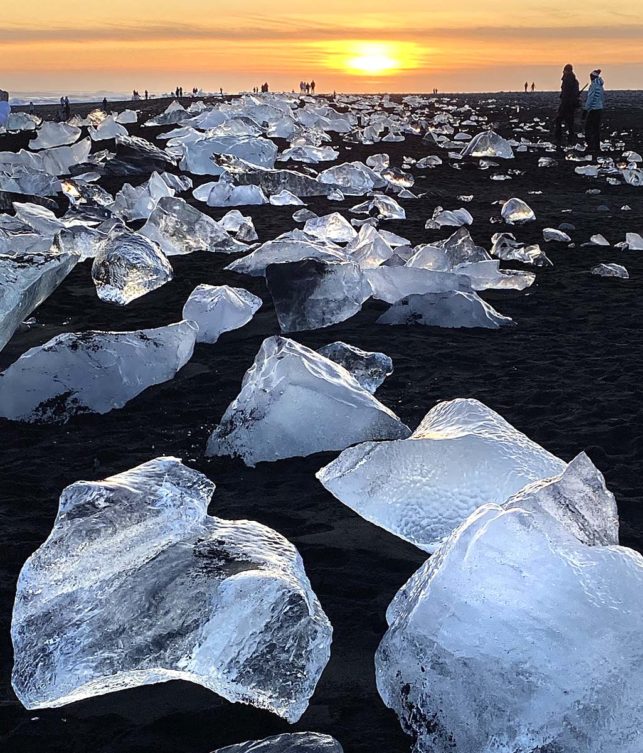
Diamond Beach, Iceland
A delicate diamond
Diamonds on Diamond Beach they are very delicate. A few rays of the sun are enough to disappear as quickly as they appeared. But that's what their beauty is all about. In the fleeting moment, in the ephemeral nature of the phenomenon.
Diamonds are pieces of icebergs of various sizes (or, more simply put, large bits of ice) that have to go a long way before becoming diamonds on a diamond beach.
First, they create a gigantic, largest glacier in Iceland Vatnajökulland when they break away from it in the form of an ice, they drift for a long time as icebergs, trapped inside a glacial lagoon Jokulsarlon.
Drifting they melt slowly, and when they are small enough to fit in the isthmus connecting the glacial lagoon with the sea waters, they set out free, to the wide sea.
Freedom, however, is very short-lived. Sea waves push the released icebergs back to land.
The process I described is perfectly visible on satellite photos on Google Maps.
I allowed myself to post a few screenshots that illustrate everything perfectly.
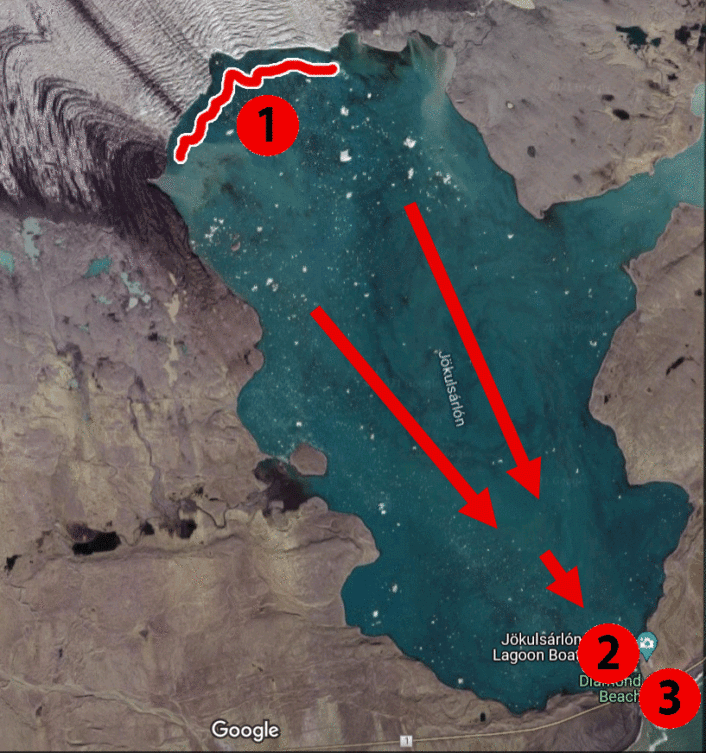
photo source: Google Maps
This photo shows the entire Jökulsárlón glacier lagoon. In the upper left corner is the tongue of the Vatnajökull glacier. From its edge (1) icebergs break off and then drift down the lagoon along the water surface, as indicated by the arrows; The mountains flow into a narrow isthmus (2) and flock there, waiting for the moment when they can cross the isthmus. After crossing the isthmus, they swim out into the open sea, and the sea waves push them back and throw them back ashore (3).
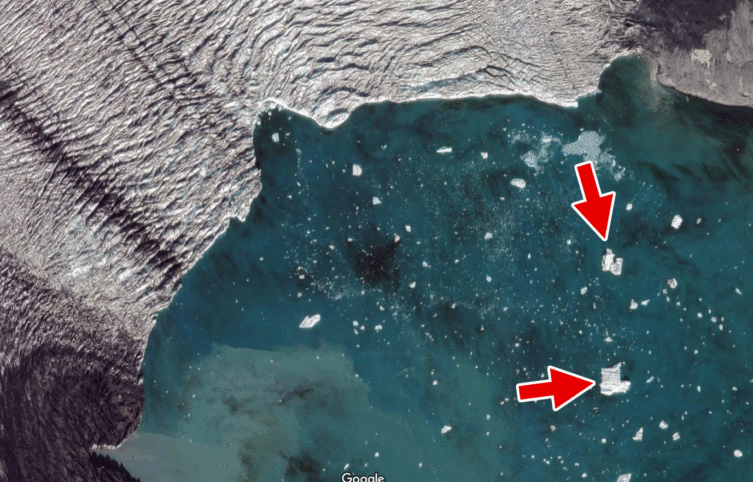
photo source: Google Maps
Above you can see an enlarged fragment of the edge of the glacier from which the icebergs break off, and several icebergs drifting across the surface of the lagoon.
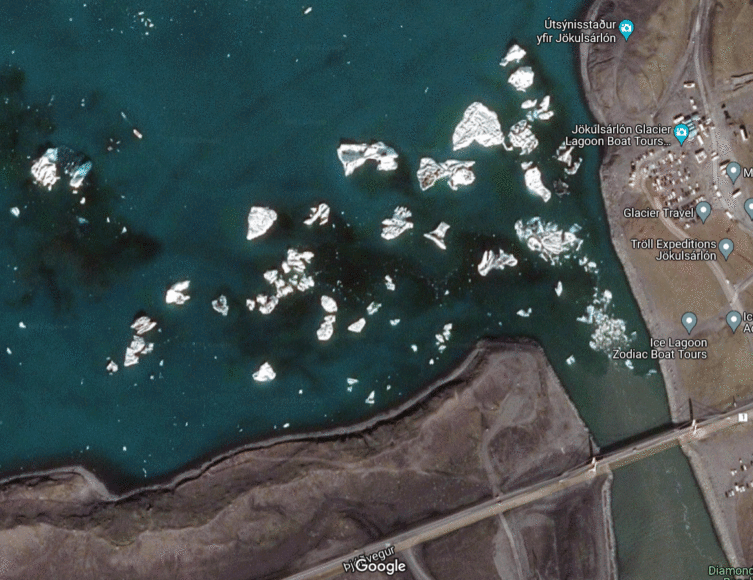
photo source: Google Maps
The above photo perfectly shows the queue where the icebergs wait before crossing the isthmus to the high seas. It must be said that the isthmus is quite crowded 🙂
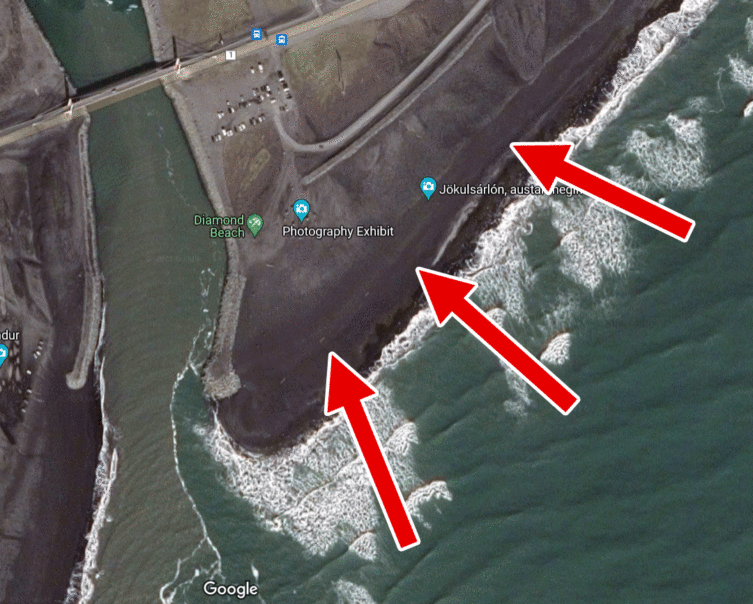
photo source: Google Maps
And the last satellite photo. Icebergs have little chance of breaking out into the high seas. Sea waves throw billets of ice on a black beach.
Iceberg graveyard
Small and quite large fragments of icebergs washed ashore by pulsating sea waves accumulate on the black beach.
Glacier ice is beautiful. Crystal clear and transparent. In the daylight it glitters and sparkles. Some rays of light it reflects, and others it allows it to pass through itself without putting up any resistance. Shiny ice shards really look like giant diamonds. The contrast they create with the blackness of the beach further emphasizes their glassy and luminous character.
Everything looks delightful, and the awareness that here, before our eyes, pieces of a glacier, this seemingly permafrost, end their thousand-year or even longer journey, adds drama to the scenery.
We are in the cemetery where the last, most persistent fragments of the glacial permafrost are reaching the end of their journey. In the rays of the sun, they die, melting and shining with a glow they have never shone before. They delight us and please our eyes. They create an endless spectacle. Washed with sea waves, they mix the sweetness of the water from which they were made with the saltiness of the sea. They slowly disappear from our sight, but soon they will be replaced by new fragments of the glacier on the way.
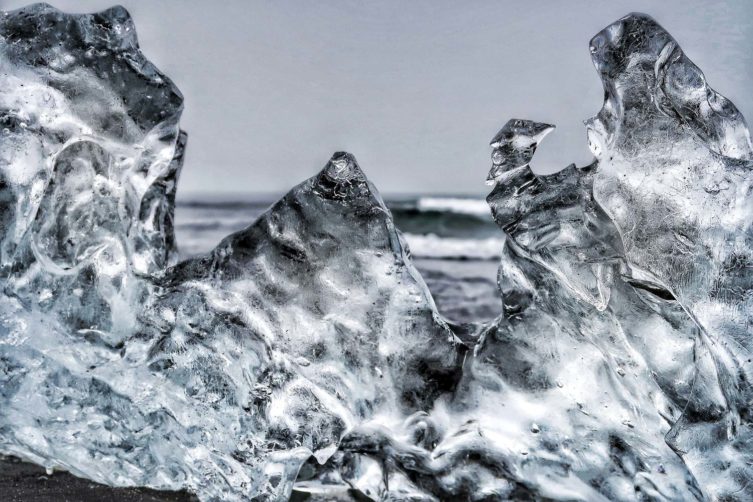
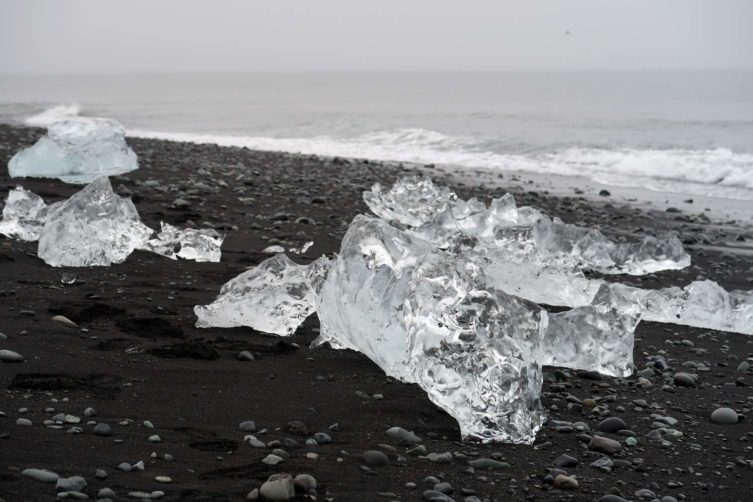
Visiting the diamond beach
The diamond beach looks most beautiful in autumn, winter and early spring, when the debris is the most abundant. Then the ice does not melt as quickly as in summer and countless diamonds accumulate on the beach. Sometimes there are so many of them that it's hard to get to the seashore. During sunrise or sunset, the view is overwhelming when the ice diamonds shine through the colored sunlight.
By the way, I do not recommend walking all the way to the waterline, because the sea waves are very tricky here. Most of them end more or less in the same place, but every few waves there is one that reaches a few or even several meters away. It is incomparably larger than the previous ones and has so much energy that it can carry really large pieces of ice with it. Getting within its range is really dangerous. Hitting a large piece of ice can be unpleasant and dangerous.
Once the wave hits the land, it sometimes takes large chunks of ice with it on the way back. By the way, it is even able to take a man.
I warn and observe. Especially in winter. Be enchanted and enjoy the charms of the diamond beach, but constantly control the waves with one eye and do not take excessive risks.
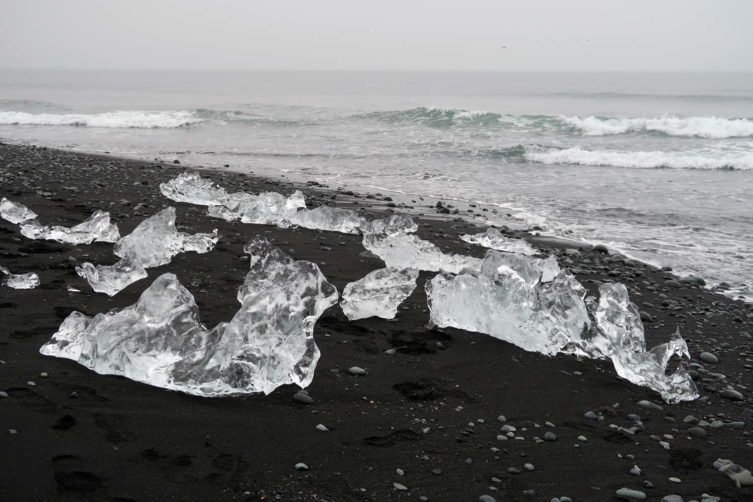
Diamond beaches are most often visited at the same time as the Jökulsarlon glacier lagoon, but the trip (if you have free time and travel freely, e.g. by renting a car) is worth including a visit to the Fjallsarlón glacier lake, just 10 km away. It is definitely smaller than the Jökulsarlon, but thanks to this you can get very close to the glacier face and see it really in detail.
Parking
The parking lot by the diamond beach is just a few meters from the main road no. 1. There is a narrow exit to the parking lot and it is worth slowing down a bit earlier so as not to pass the exit.
There is also a slightly larger parking lot nearby for tourist traffic at the Jökulsarlon glacier lagoon.
There is no point in driving between these parking lots when visiting both attractions. They are so close together that it is worth taking those few steps on your feet. The path runs along the isthmus through which water and heavily melted icebergs flow out to the open sea.
If there are no vacancies in the car park by the diamond beach, you can go to the car park by the glacier lagoon.
You can find the coordinates of both parking lots below.
Parking at the Diamond Beach, GPS coordinates:
64°02’43.3″N 16°10’38.0″W
64.045372, -16.177231 - click and route
Parking at the Jökulsarlon glacier lagoon, GPS coordinates:
64°02’52.9″N 16°10’48.8″W
64.048027, -16.180211 - click and route
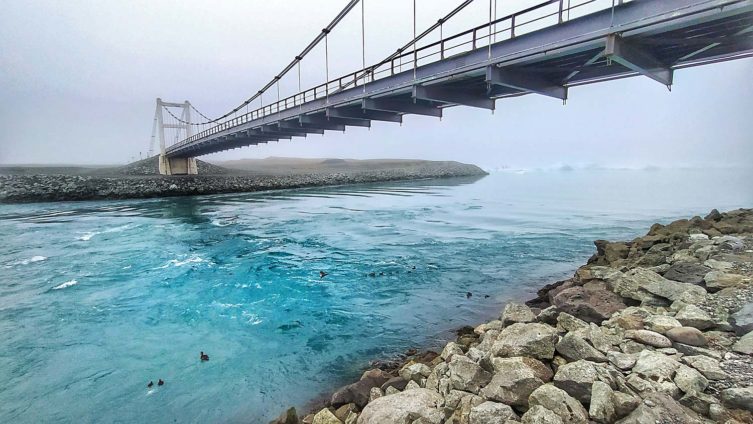
Accommodation near the Diamond Beach
The part of Iceland where the Diamond Beach is located is one of those that, due to its remoteness from the capital, is the least visited by tourists. If you've arrived here, you will definitely need an overnight stay.
So I prepared a special link, thanks to which the search results are ordered according to the distance of the hotel from the Diamond Beach. The further you go, the lower the search results. Just click and search for accommodation near the Diamond Beach - [click]
In addition, below you will find some interesting, specific proposals for accommodation I found.
Reynivellir II - [click]
Gerdi Guesthouse - [click]
Skyrhúsid Guest House - [click]
Iceland sightseeing itinerary
The entry you are reading is an element prepared by me Iceland sightseeing plan. Most likely, everything you need to prepare for your trip to Iceland can be found in this entry. Weather, accommodation, car rentals, tourist attractions and a map of a trip around Iceland ... all in one place: Iceland - map and sightseeing plan, tourist attractions, excursions, the most beautiful places - [click]. Be sure to read!Important to me!
Give the article a good rating (5 stars welcome 😀)!It's free, a for me it is very important! The blog lives on visits and thus has a chance to develop. Please do it and ... thank you in advance!
If you like my guides, you will certainly find the one I created useful guide catalog - [click]. There you will find ready-made ideas for your next trips, descriptions of other tourist destinations and an alphabetical list of guides divided into countries, cities, islands and geographical regions.
I also post link to Facebook profile - [click]. Come in and press "Follow"then you will not miss new, inspiring posts.
Unless you prefer Instagram. I'm not a social media demon, but you can always count on something nice to look at on my instagram profile - [click]. The profile has just been created, so for now he is starving, due to the lack of followers. He is happy to receive any observer who feeds him with his love.
I make the content I create available free of charge with copyright, and the blog survives from advertising and affiliate cooperation. So, automatic ads will be displayed in the content of the articles, and some links are affiliate links. This has no effect on the final price of the service or product, but I may earn a commission for displaying ads or following certain links. I only recommend services and products that I find good and helpful. Since the beginning of the blog's existence, I have not published any sponsored article.
Some of the readers who found the information here very helpful, sometimes ask me how you can support the blog? I do not run fundraisers or support programs (type: patronite, zrzutka or "buy coffee"). The best way is to use links. It costs you nothing, and support for the blog is self-generating.
Pozdrawiam



